Citroen C5 2015 (RD/TD) / 2.G Owner's Manual
Manufacturer: CITROEN, Model Year: 2015, Model line: C5, Model: Citroen C5 2015 (RD/TD) / 2.GPages: 344, PDF Size: 12.95 MB
Page 231 of 344

229
C5_en_Chap08_information_ed01-2014
"Multimedia":
Wi-Fi on board, 230V socket, audio systems,
speakers, semi-integral navigation systems,
portable navigation systems, hands-free kit,
DVD player, USB Box, mapping update CD,
driving aid, Hi-Fi module...The fitting of electrical equipment or
accessories which are not recommended
by CITROËN may result in a failure of
your vehicle's electronic system and
excessive electrical consumption.
Contact a CITROËN dealer
for information on the range of
recommended equipment and
accessories.
Installation of radio
communication
transmitters
Before installing any after-market radio
communication transmitter, you can
contact a CITROËN dealer for the
specification of transmitters which can
be fitted (frequency, maximum power,
aerial position, specific installation
requirements), in line with the Vehicle
Electromagnetic Compatibility
Directive (2004/104/EC). Depending on the legislation in force in
the country, certain safety equipment
may be compulsory: high visibility
safety vests, warning triangles,
breathalyzers, spare bulbs, spare fuses,
fire extinguisher, first aid kit, mud flaps
at the rear of the vehicle.
8
Practical information
Page 232 of 344

230
C5_en_Chap09_verification_ed01-2014
ToTaL & CITRoËn
Partners in performance and
protecting the environment
Innovation in the search for
performance
For over 40 year, the TOTAL Research and
Development departments have developed for
CITROËN, lubricants to match the latest technical
innovations on CITR
oËn
vehicles, both for
competition and for everyday motoring.
For you, this is an assurance that you will obtain of the
best per formance for your engine.
Optimum protection for your
engine
By having your CITROËN vehicle
serviced with TOTAL lubricants, you are
contributing towards improving the life
and per formances of your engine, while
also protecting the environment.
prefers
Checks
Page 233 of 344

231
C5_en_Chap09_verification_ed01-2014
bonnet
Opening
F at the front of the bonnet, lift the safety catch B and raise the bonnet.
F Unclip the stay C from its housing and pivot
it to insert it in the notch D indicated by a
yellow arrow.
F
F
ix the stay in the notch to hold the bonnet
open.Closing
F Take the stay out of the support notch.
F C lip the stay in its housing.
F
L
ower the bonnet then slam it firmly at the
end of its travel.
F
P
ull on the bonnet to check that it is fully
closed.
F
O
pen the left hand front door.
F
P
ull the interior bonnet release lever A ,
located at the bottom of the door frame. Before doing anything under the bonnet,
switch off the Stop
& Start system to
avoid any risk of injury resulting from an
automatic change to START mode. The location of the interior release lever
prevents opening of the bonnet while
the left hand front door is closed.
This operation must only be carried out
when the vehicle is stationary.
Avoid opening the bonnet in strong
winds.
When the engine is hot, handle the
safety catch and bonnet stay with care
(risk of burns).
be
cause of the presence of electrical
equipment under the bonnet, it is
recommended that exposure to water
(rain, washing, ...) be limited.
The cooling fan may star t after
switching off the engine: take care
with articles and clothing that might
be caught by the fan blades.
9
Checks
Page 234 of 344
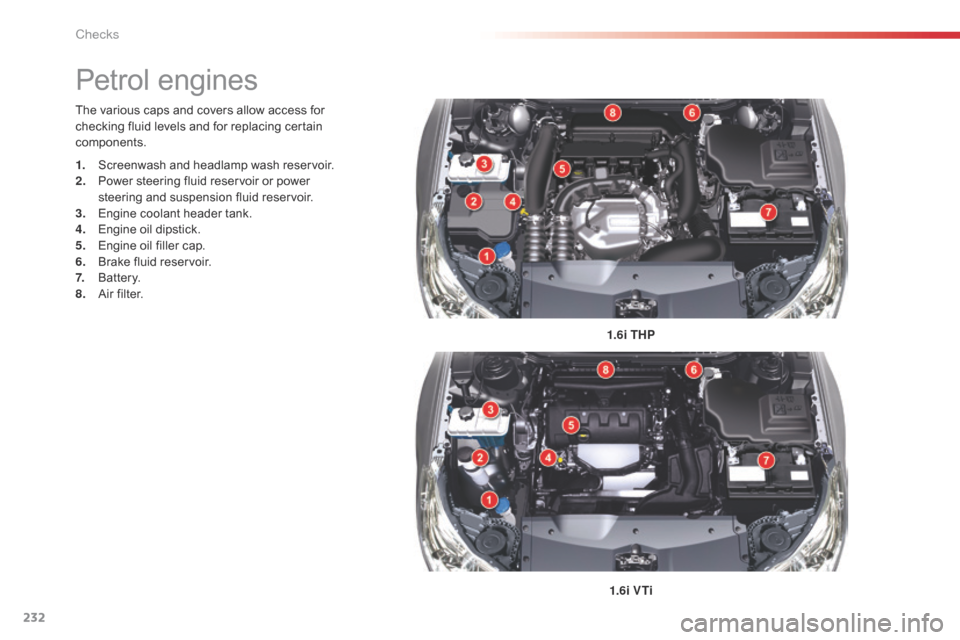
232
C5_en_Chap09_verification_ed01-2014
The various caps and covers allow access for
checking fluid levels and for replacing certain
components.1.6i THP
1.6i V Ti
Petrol engines
1. Screenwash and headlamp wash reservoir.
2. P ower steering fluid reservoir or power
steering and suspension fluid reservoir.
3.
E
ngine coolant header tank.
4.
E
ngine oil dipstick.
5.
E
ngine oil filler cap.
6.
B
rake fluid reservoir.
7.
B
attery.
8.
A
ir filter.
Checks
Page 235 of 344
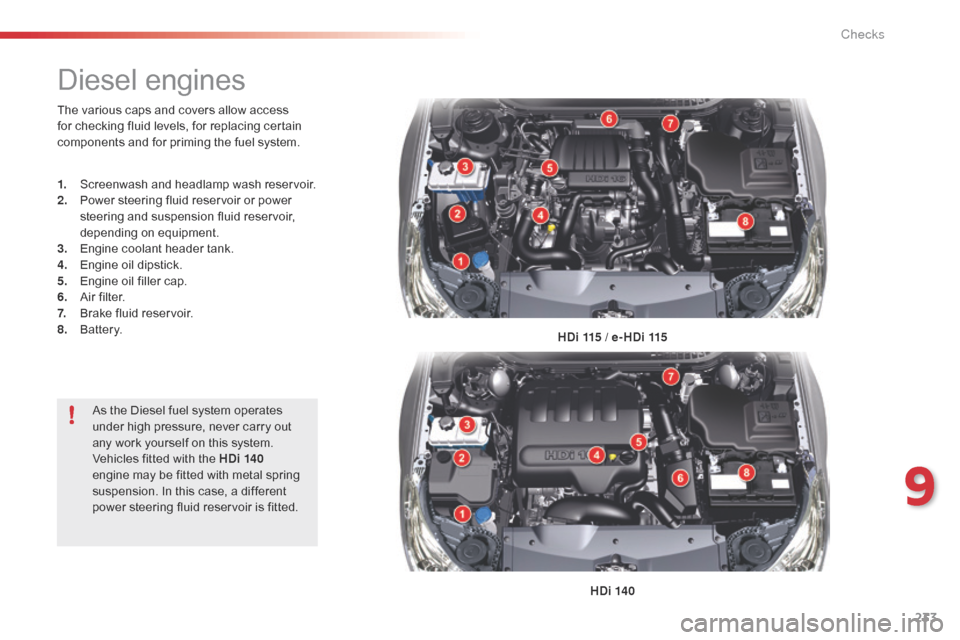
233
C5_en_Chap09_verification_ed01-2014
Diesel engines
HDi 115 / e- HDi 115
HDi 140
The various caps and covers allow access
for checking fluid levels, for replacing certain
components and for priming the fuel system.
1.
S
creenwash and headlamp wash reservoir.
2.
P
ower steering fluid reservoir or power
steering and suspension fluid reservoir,
depending on equipment.
3.
E
ngine coolant header tank.
4.
E
ngine oil dipstick.
5.
E
ngine oil filler cap.
6.
A
ir filter.
7.
B
rake fluid reservoir.
8. B
attery.
As the Diesel fuel system operates
under high pressure, never carry out
any work yourself on this system.
Vehicles fitted with the HDi 140
engine may be fitted with metal spring
suspension. In this case, a different
power steering fluid reservoir is fitted.
9
Checks
Page 236 of 344
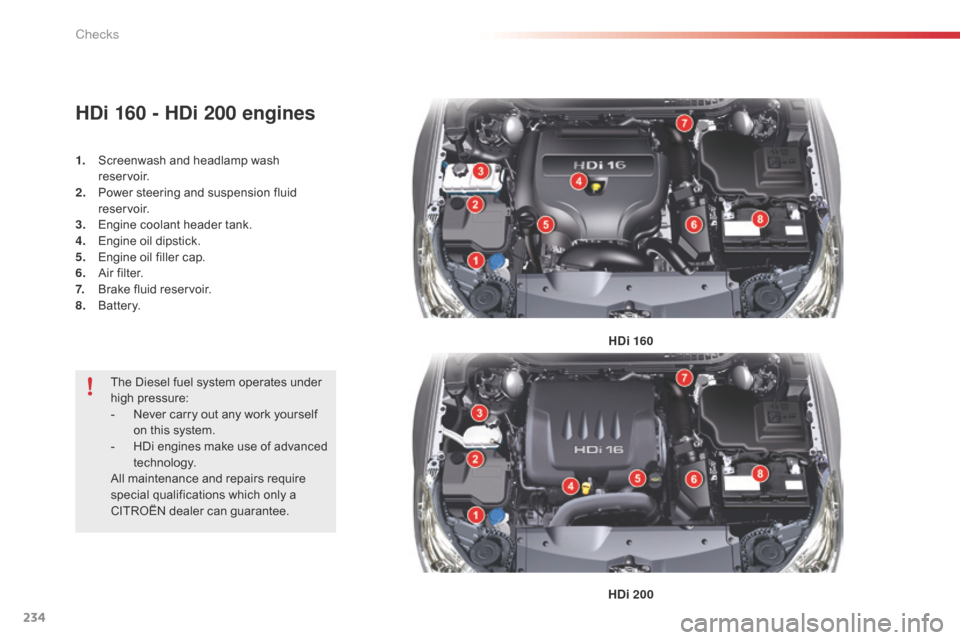
234
C5_en_Chap09_verification_ed01-2014
HDi 160 - HDi 200 engines
1. Screenwash and headlamp wash reservoir.
2.
P
ower steering and suspension fluid
reservoir.
3.
E
ngine coolant header tank.
4.
E
ngine oil dipstick.
5.
E
ngine oil filler cap.
6.
A
ir filter.
7.
B
rake fluid reservoir.
8.
B
attery. HDi 160
HDi 200
The Diesel fuel system operates under
high pressure:
-
N
ever carry out any work yourself
on this system.
-
H
Di engines make use of advanced
technology.
All maintenance and repairs require
special qualifications which only a
CITROËN dealer can guarantee.
Checks
Page 237 of 344
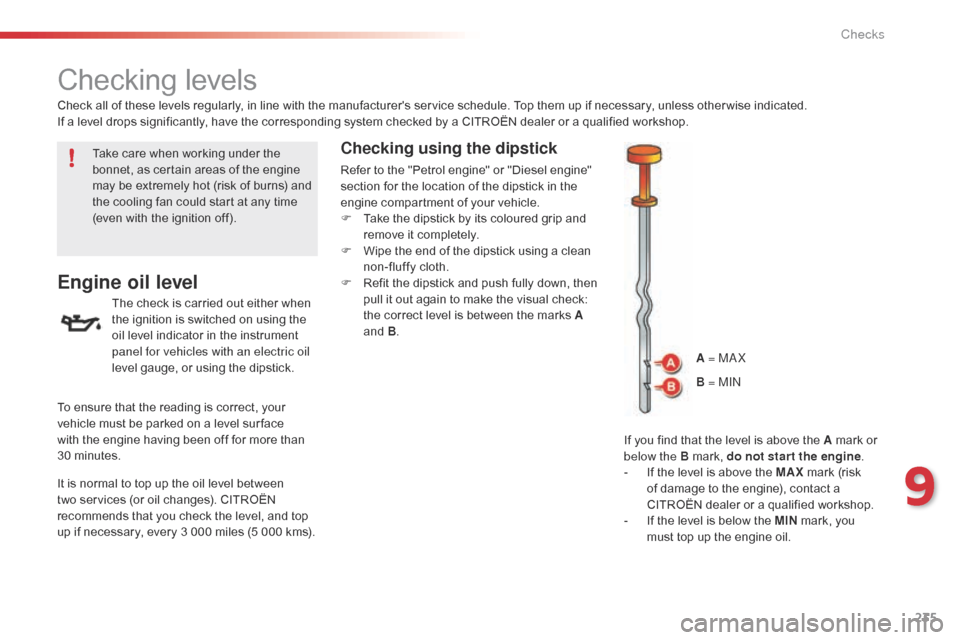
235
C5_en_Chap09_verification_ed01-2014
Checking levels
Engine oil level
The check is carried out either when
the ignition is switched on using the
oil level indicator in the instrument
panel for vehicles with an electric oil
level gauge, or using the dipstick.
Check all of these levels regularly, in line with the manufacturer's service schedule. Top them up if necessary, unless other wise indicated.
If a level drops significantly, have the corresponding system checked by a CITROËN dealer or a qualified workshop.
If you find that the level is above the A mark or
below the B mark, do not star t the engine.
-
I
f the level is above the MAX mark (risk
of damage to the engine), contact a
CITROËN dealer or a qualified workshop.
-
I
f the level is below the MIN mark, you
must top up the engine oil.
Take care when working under the
bonnet, as certain areas of the engine
may be extremely hot (risk of burns) and
the cooling fan could start at any time
(even with the ignition off).
To ensure that the reading is correct, your
vehicle must be parked on a level sur face
with the engine having been off for more than
30 minutes.
It is normal to top up the oil level between
two services (or oil changes). CITROËN
recommends that you check the level, and top
up if necessary, every 3 000 miles (5 000 kms).
Checking using the dipstick
Refer to the "Petrol engine" or "Diesel engine"
section for the location of the dipstick in the
engine compartment of your vehicle.
F
T
ake the dipstick by its coloured grip and
remove it completely.
F
W
ipe the end of the dipstick using a clean
non-fluffy cloth.
F
R
efit the dipstick and push fully down, then
pull it out again to make the visual check:
the correct level is between the marks A
and B .
A = M
aX
B
= MI
n
9
Checks
Page 238 of 344

236
C5_en_Chap09_verification_ed01-2014
Oil grade
Before topping-up the oil or changing the oil,
check that the oil is the correct grade for your
engine and conforms to the manufacturer's
recommendations.
Topping up the engine oil level
Refer to the "Petrol engine" or "Diesel engine"
section for the location of the oil filler cap in the
engine compartment of your vehicle.
F
U
nscrew the oil filler cap to reveal the filler
aperture.
F
A
dd oil in small quantities, avoiding any
spills on engine components (risk of fire).
F
W
ait a few minutes before checking the
level again using the dipstick.
F
A
dd more oil if necessary.
F
A
fter checking the level, carefully refit the
oil filler cap and the dipstick in its tube.
After topping up the oil, the check when
switching on the ignition with the oil level
indicator in the instrument panel is not valid
during the 30 minutes after topping up.
Engine oil change
Refer to the manufacturer's service schedule
for details of the interval for this operation.
In order to maintain the reliability of the engine
and emission control system, never use
additives in the engine oil.
Checks
Page 239 of 344
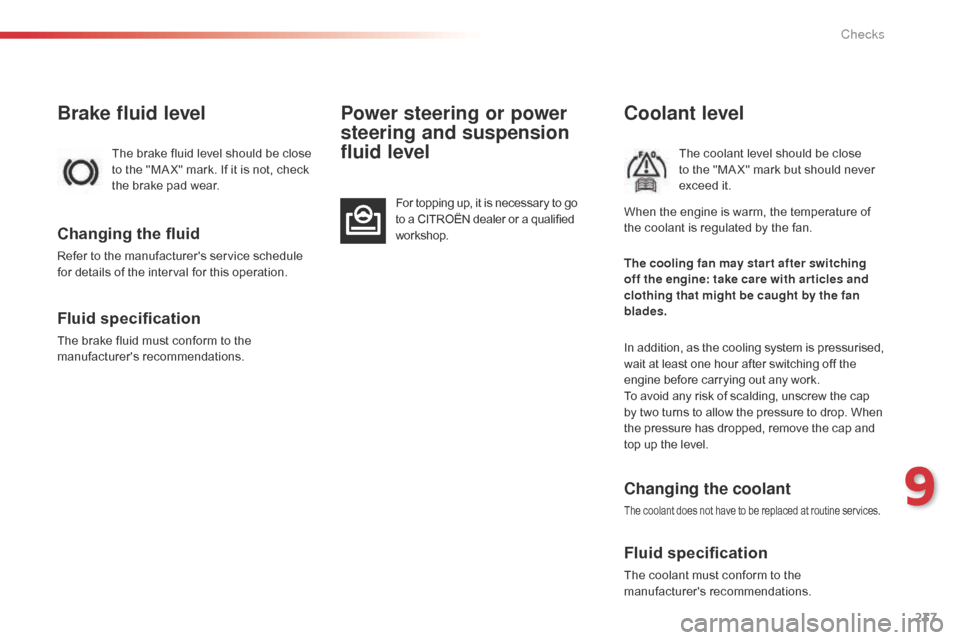
237
C5_en_Chap09_verification_ed01-2014
Brake fluid level
The brake fluid level should be close
to the "MA X" mark. If it is not, check
the brake pad wear.
Changing the fluid
Refer to the manufacturer's service schedule
for details of the interval for this operation.
Fluid specification
The brake fluid must conform to the
manufacturer's recommendations.
Power steering or power
steering and suspension
fluid level
For topping up, it is necessary to go
to a CITROËN dealer or a qualified
workshop.
Coolant level
The coolant level should be close
to the "MA X" mark but should never
exceed it.
Changing the coolant
The coolant does not have to be replaced at routine services.
Fluid specification
The coolant must conform to the
manufacturer's recommendations. The cooling fan may star t after switching
off the engine: take care with ar ticles and
clothing that might be caught by the fan
blades.
In addition, as the cooling system is pressurised,
wait at least one hour after switching off the
engine before carrying out any work.
To avoid any risk of scalding, unscrew the cap
by two turns to allow the pressure to drop. When
the pressure has dropped, remove the cap and
top up the level. When the engine is warm, the temperature of
the coolant is regulated by the fan.
9
Checks
Page 240 of 344

238
C5_en_Chap09_verification_ed01-2014
Diesel additive level
(Diesel
e
ngine with particle
filter)
To p p i n g u p
This additive must be topped up by a CITROËN
dealer or a qualified workshop without delay.
Used products
The additive reservoir low level is
indicated by fixed illumination of
this warning lamp, accompanied by
an audible warning and a message
in the multifunction screen.
Screenwash and headlamp
wash fluid
In the case of vehicles fitted with
headlamp washers, the low fluid level
is indicated by an audible signal and
a message in the screen.
Fluid specification
For optimum cleaning and to avoid freezing,
this fluid must not be topped up with or
replaced with plain water.
Reservoir capacity (depending on version).
-
s
creenwash fluid: approximately 3.5 litres,
-
s
creenwash and headlamp wash fluid:
approximately 6.15 litres.
Top up the reservoir when you next stop
the
vehicle. Avoid prolonged contact of used oil or
fluids with the skin.
Most of these fluids are harmful to
health or indeed very corrosive.
Do not discard used oil or fluids into
sewers or onto the ground.
Take used oil to a CITROËN dealer or
a qualified workshop (France) or to an
authorised waste disposal site.
Checks